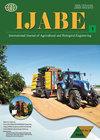Determination of energy use efficiency and greenhouse gas emissions in peach production
IF 2.2
2区 农林科学
Q2 AGRICULTURAL ENGINEERING
International Journal of Agricultural and Biological Engineering
Pub Date : 2023-01-01
DOI:10.25165/j.ijabe.20231602.7917
引用次数: 0
Abstract
: The purpose of this study was to determine the energy use efficiency and greenhouse gas (GHG) emissions in peach production that took place in Kırklareli province of Turkey during the 2020-2021 production season. This study included calculations of energy input, energy output, energy use efficiency, specific energy, energy productivity, net energy, energy input types, GHG emissions and GHG ratio. Survey, observation and data calculations are related to the 2020-2021 production season. The data obtained from the study were collected from 16 different farms (reachable) through face-to-face surveys with full count method. Energy input and energy output were calculated as 19 570.58 MJ/hm 2 and 19 471.94 MJ/hm 2 , respectively. With regards to production inputs, 55.70% of the energy inputs consisted of chemical fertilizers energy (10 900.03 MJ/hm 2 ), 9.46% consisted of chemicals energy (1852.10 MJ/hm 2 ), 9.32% consisted of human labour energy (1823.13 MJ/hm 2 ), 7.65% consisted of electricity energy (1497.28 MJ/hm 2 ), 6.91% consisted of diesel fuel energy (1351.52 MJ/hm 2 ), 4.73% consisted of irrigation water energy (926.10 MJ/hm 2 ), 3.43% consisted of machinery energy (671.98 MJ/hm 2 ), 1.88% consisted of transportation energy (367.72 MJ/hm 2 ), 0.88% consisted of farmyard manure energy (171.80 MJ/hm 2 ) and 0.05% consisted of lime energy (8.94 MJ/hm 2 ). Energy use efficiency, specific energy, energy productivity and net energy were calculated as 0.99, 1.91 MJ/kg, 0.52 kg/MJ and –98.64 MJ/hm 2 , respectively. The consumed total energy input in production was classified as 28.60% direct energy, 71.40% indirect energy, 14.93% renewable energy and 85.07% non-renewable. Total GHG emissions and GHG ratio were calculated as 1683.24 kgCO 2-eq /hm 2 and 0.16 kg CO 2-eq /kg, respectively.桃生产中能源利用效率和温室气体排放的测定
本研究的目的是确定2020-2021年生产季节土耳其Kırklareli省桃子生产的能源利用效率和温室气体(GHG)排放。本研究包括能源投入、能源产出、能源利用效率、比能、能源生产率、净能、能源投入类型、温室气体排放和温室气体比率的计算。调查、观察和数据计算与2020-2021年的生产季节有关。通过面对面调查,采用全计数法,从16个不同的农场(可达)收集数据。能量输入和能量输出分别为19 570.58 MJ/hm 2和19 471.94 MJ/hm 2。在生产投入中,55.70%为化肥能(10 900.03 MJ/hm 2), 9.46%为化学能(1852.10 MJ/hm 2), 9.32%为人力能(1823.13 MJ/hm 2), 7.65%为电能(1497.28 MJ/hm 2), 6.91%为柴油能(1351.52 MJ/hm 2), 4.73%为灌溉水能(926.10 MJ/hm 2), 3.43%为机械能(671.98 MJ/hm 2)。其中运输能(367.72 MJ/hm 2)占1.88%,农家肥能(171.80 MJ/hm 2)占0.88%,石灰能(8.94 MJ/hm 2)占0.05%。能量利用效率、比能、能量生产力和净能分别为0.99、1.91 kg、0.52 kg/MJ和-98.64 MJ/hm 2。生产中消耗的总能源投入中直接能源占28.60%,间接能源占71.40%,可再生能源占14.93%,不可再生能源占85.07%。总温室气体排放量和温室气体比值分别为1683.24 kgCO 2-eq /hm 2和0.16 kgCO 2-eq /kg。
本文章由计算机程序翻译,如有差异,请以英文原文为准。
求助全文
约1分钟内获得全文
求助全文
来源期刊

International Journal of Agricultural and Biological Engineering
AGRICULTURAL ENGINEERING-
CiteScore
4.30
自引率
12.50%
发文量
88
审稿时长
24 weeks
期刊介绍:
International Journal of Agricultural and Biological Engineering (IJABE, https://www.ijabe.org) is a peer reviewed open access international journal. IJABE, started in 2008, is a joint publication co-sponsored by US-based Association of Agricultural, Biological and Food Engineers (AOCABFE) and China-based Chinese Society of Agricultural Engineering (CSAE). The ISSN 1934-6344 and eISSN 1934-6352 numbers for both print and online IJABE have been registered in US. Now, Int. J. Agric. & Biol. Eng (IJABE) is published in both online and print version by Chinese Academy of Agricultural Engineering.
 求助内容:
求助内容: 应助结果提醒方式:
应助结果提醒方式:


